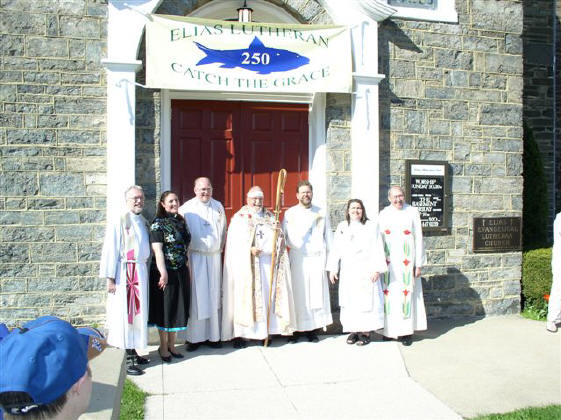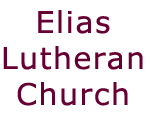|
28 Years before the
founding of Emmitsburg in 1785, there was a Tom’s Creek Church. A few
Lutheran families in 1757 purchased an acre of land to
construct a log church about three miles east of today’s
Emmitsburg, Maryland. 
The first pastor was
Reverend John George Bager (Baugher) who lived near
Hanover and also served congregations from Baltimore,
Maryland to Chambersburg, Pennsylvania. He was pastor at
Tom’s Creek Church for two years.
Many of the
"fathers" of the first Tom’s Creek Lutheran
Church are still familiar names to Elias Evangelical
Lutheran Church today; such as Smith, Eyster, Maxwell,
Shriver, Troxell, Martin, Ohler, Gillelan and Rowe, to
name a few.
The church was without
a regular pastor for two years (1759–61); then Ludwig
Beck served for six years (1761–67). The church was
again without a regular pastor until Reverend Charles F.
Wildbahn, who served for thirteen years (1769-82).
After Reverend Wildbahn
left the parish, the Lutheran and Reformed congregations
united. They built a new church and schoolhouse on the
same spot as the old church. Both churches were about 35
yards south of the Lutheran Cemetery, across the road
with the front door facing south. There was a hitching
post in front of the cemetery. The cemetery was enclosed
with a wrought iron fence in later years. Helman writes
they buried some bodies three and four deep, because
theirs was the only graveyard for miles. This is one of
the oldest burial grounds in the Emmitsburg area.
In 1797, the
congregation decided to build a new church in
Emmitsburg. The Methodists purchased Tom’s Creek
Church, but there is no record anywhere of that sale.
The first Lutheran
minister at Emmitsburg was Reverend John F. Ruthrouff.
Reverend Ruthrouff passed away in 1837 at the age of 74.
One half acre was
purchased by Thomas Maxwell from William Emmit for
$100.00 and given to the congregation in 1802. The
church was built of stones from the area. It was very
plain with only one door facing east and four windows.
The walls were three feet thick and wooden pins joined
the hand-hewn timbers in the attic. It is the oldest
non-residence building in use in the area.
An architect, Peter
Troxell, and builder, George Smith, built the steeple in
1814. The 120-foot steeple was built at a cost of
$1,523.56½. The money was raised with a lottery
authorized by the General Assembly in Annapolis,
Maryland. In 2000, a basket lottery was used to help pay
for repairs and painting.
Helman’s history says
a clock with wooden works was built by John Hughes of
Taneytown, Maryland, and was placed in the steeple. It
was used until 1860. Also at this time, a four-foot fish
weathervane was used. The fish is an ancient symbol of
Christianity and the weathervane is on display today in
the church.
Elias had a German
speaking service until 1828 when the service was changed
to English by popular demand. The Union Sabbath School
was the predecessor of our present Sunday School. It
served both the Lutheran and Reformed congregations. In
1868, when the Reformed people left, the Union Sabbath
School ceased. In 1870, Elias adopted a constitution and
the school began Sabbath School of Elias Evangelical
Lutheran Church. The school was under supervision of the
pastor until 1964. The school was then turned over to
the Parish Education Committee. Now the school was the
church council’s responsibility where before it was
separate from the church with its own financial support.
A schoolhouse was built
in 1829 on the church grounds which is now part of the
cemetery. It was called The Union Academy. The purpose
of the school was to teach religion along with secular
subjects to the children. At first this was only for the
congregation; then they opened it to children of the
parish. The academy was a brick building about fifty
feet west of the church and was used about forty years.
The enrollment could never exceed forty students. When
our cemetery was enlarged in 1870, The Union Academy was
torn down.
Andrew Eyster, a
silversmith, made the sacramental vessels which are
still used today.
In 1868, the narthex,
or front entrance, was built and a new charter and
constitution was formed. Reverend Elias Johnston was the
pastor at this time. The first constitution was adopted
in 1870. The constitution at present time was adopted in
1987.
Elias’s first
parsonage was purchased in 1868 and was used for 53
years. In 1921, the present parsonage was built for less
than $10,000.
Flora Belle Ohler was
born in Emmitsburg in March 1866 and entered the
Lutheran Deaconess Motherhouse in September 1907. After
much service, her eye sight caused her to retire to the
Motherhouse and she passed away in July 1955.
The Reformed
congregation withdrew from Elias in 1869 after 87 years
as a Union Church. The Lutherans had 390 members in
their congregation and the Reformed consisted of 47
families.
The first organ at
Elias came in 1883 and they needed an organ pumper. He
was paid $1.25 per month. The second organ was installed
in 1890 and was used until the present one was purchased
in 1971.
The memorial stained
glass windows and pews were installed at the centennial
of the church in 1897. In 1972, they were valued at
$27,500. The
women were not involved in the administration of the
congregation until 1897. The first female deacon was
Helen McNair, elected in 1966.
The church grounds
really increased in the latter half of the 19th century.
Water was piped to the parsonage in 1885.
Reverend Day began his
pastorate September 5, 1920. He and his family lived
with parishioners until the new parsonage was completed.
They moved in April 1921.
The church made many
physical improvements because October 1922 was the 125th
anniversary and the cornerstone for the present Parish
Hall was laid. In 1924, the congregation voted a senior
of the Gettysburg Theological Lutheran Seminary, Philip
Bower, as pastor following his graduation. He was
officially installed July 12, 1925. During his
pastorate, the Parish Hall was built and dedicated on
September 14, 1930.
From 1930 to 1940,
Elias purchased additional property and a two-car garage
was erected. The property value more than doubled from
1935–1947.
The adjoining Tokar
property was purchased and the buildings removed and a
driveway was installed from Main Street to the church.
Again, many improvements were made the next few years.
In 1948, the Hymn
Player and Westminster Automatic Clock striker was
installed and the organ rebuilt.
The present stone pier
fence in front of the church and Parish Hall was
installed in 1952. The
steeple was remodeled in 1955 and a stainless steel
cross erected. The sanctuary was redecorated in 1957 for
the upcoming 200th year of the congregation.
Pastor Bower served
Elias and Emmitsburg 37 years until 1962.
The next three decades
brought a lot of changes in the church government,
parish education, ecumenism and liturgy. Reverend Ronald
Fearer was the pastor during this time. Elias replaced
the constitution in 1962 that had governed the church
since 1871. In
1966, the first woman was elected a deacon of the
church.
In August 1964, a
meeting of the five Protestant churches considered an
ecumenical weekday school. Pastor Fearer was director
and the school met for nine years on Wednesdays after
school. Elias had a bus that took children home.
The Community Vacation
School began locally in 1931 and was held for two weeks
in the morning. Now it is held in the evening so more
children can attend and more teachers are available.
Working relationships
among the churches of the parish was the most dramatic
and obvious change that was made during Reverend Ronald
Fearer’s pastorate. They cooperated through a council
of churches in the common concerns of evangelism, parish
education, social ministry, worship and music. In 1966,
a special prayer service for world peace was held in St.
Joseph’s Catholic Church and Pastor Fearer was the
first Protestant pastor ever to officiate at St. Joseph’s
Church.
The Council Of Churches
in 1967 offered the first ecumenical service for
Christian unity in Emmitsburg. St. Joseph’s Church
joined the Council of Churches in 1970, followed by St.
Anthony’s Church and the Provincial House.
The liturgy was the
major area of change in Elias. Until 1963, Holy
Communion was given four times a year. In 1996, Holy
Communion is administered every week. The new pipe organ
was installed in 1971. The
acolytes were formed in 1970, hoping to get the children
to participate. The program was very successful.
The LCA recommended in
the 1970 convention that churches cease to make
confirmation the prerequisite for receiving Holy
Communion. First Communicants were set at 10 years of
age.
Ronald E. Reaves became
the first male member of Elias to enter the Lutheran
seminary and was ordained in 1972. In 1997, Elias Church
celebrated the 200th anniversary of its present
sanctuary and the 240th anniversary of its founding. The
congregation called its first female pastor, Susan Yatta,
in 1997.
As of 2002, Elias
Church has an interim pastor, David Knodel. Come join us
on Sunday morning for Sunday School at 9:00 a.m. and
church at 10:30 a.m.
Read
Other Historical Articles by Shirley Troxel Rohrbaugh
Back
to Previous Page > |

